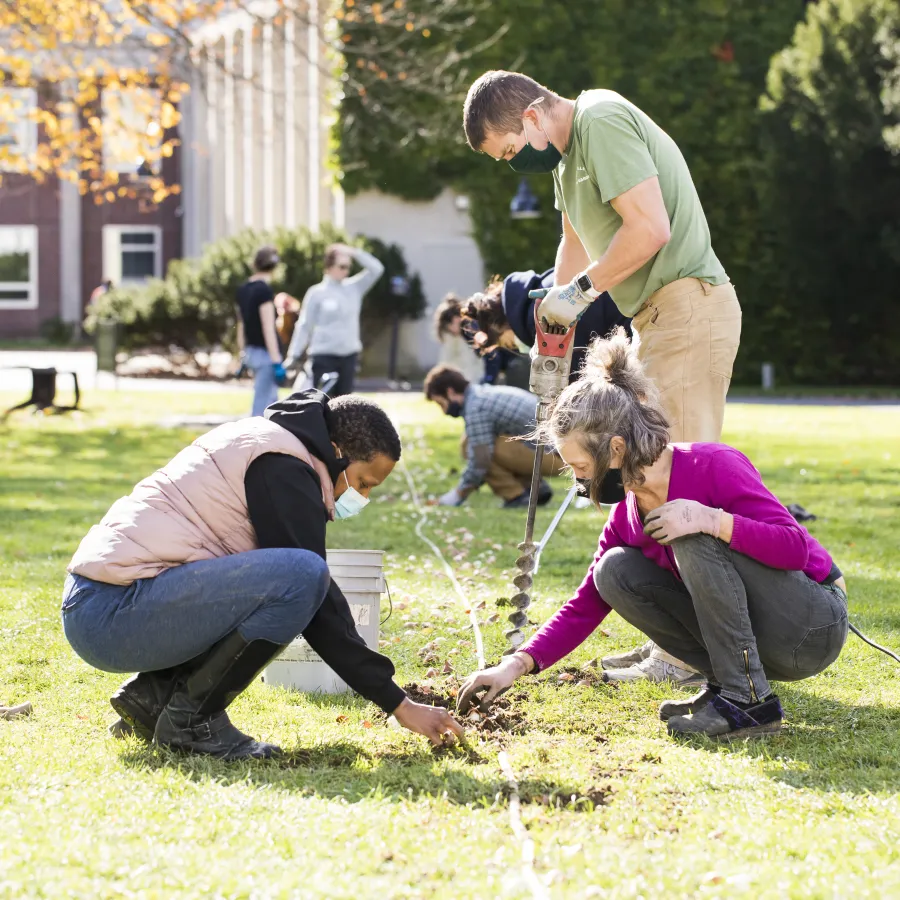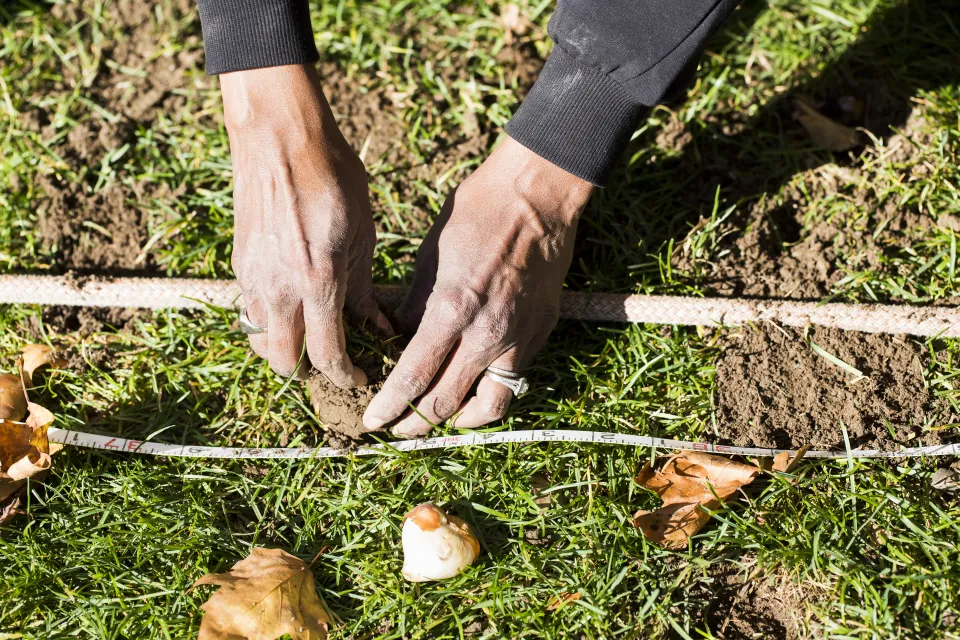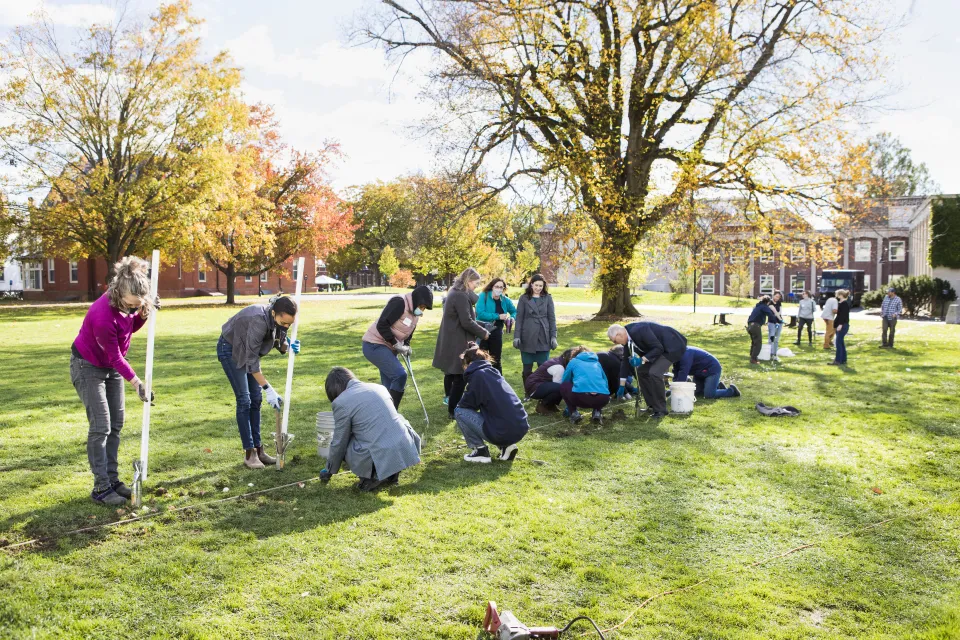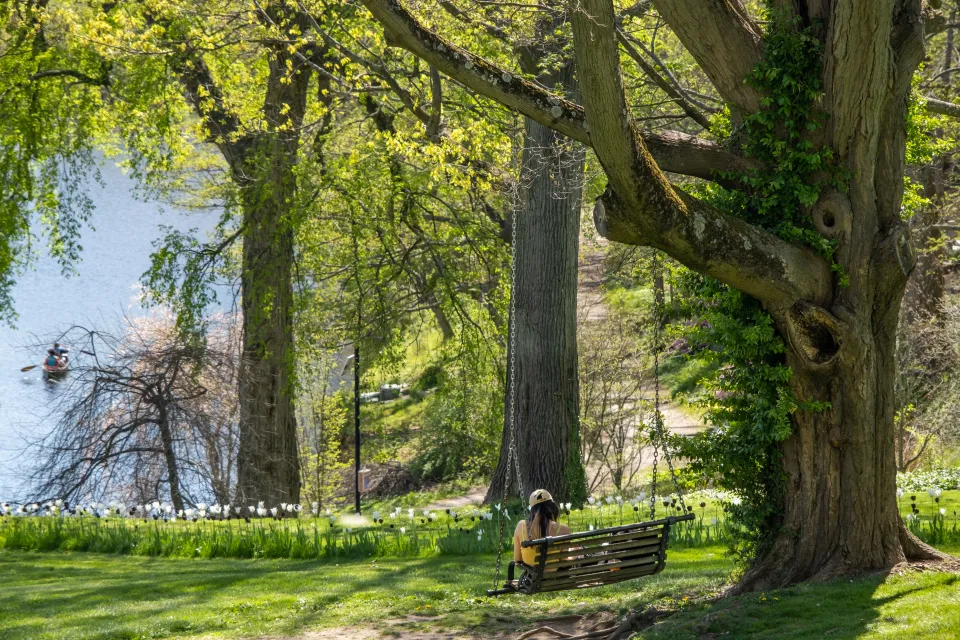Amanda Williams’ Imprint on Campus
Botanic Garden - Leaflet

Published March 25, 2023
Leaflet 2022
When a world-renowned visual artist conceptualizes planting tulips as part of her commissioned artwork, you get involved. Especially when that artist is Chicago-based Amanda Williams, whose projects have an extraordinary power to cultivate connection and community. And especially when the tulip planting is part of the third piece of An Imposing Number of Times (2020–22), Williams’ multifaceted project created as a commission for the Smith College Museum of Art (SCMA) to explore how campus traditions create and transmit a sense of belonging.
An Imposing Number of Times was born out of Williams’ monthlong artist residency at Smith College in 2019, and responds to the Black Lives Matter banners that hung on the facades of Smith’s residential houses. The work consists of three parts. The first is two black-and-white banners, each a collage of digital images of the student-made Black Lives Matter banners. The second is three handmade tea sets, a reference to Smith’s longstanding teatime tradition. One set is now in the SCMA collection, and the other two will be used at the President’s House and Mwangi Cultural Center. The third component is the temporary installation of tulips planted on three desired, or remembered, paths throughout campus.
In order to make the idea of lines of tulips dotted across various campus lawns a reality, Williams worked with the Smith College Museum of Art and the Botanic Garden of Smith College, as well as with students, staff, and faculty. Altogether, people planted almost 4,000 white and dark purple (nearly black) tulips. The tulips will bloom only once, in the spring of 2022; after that, the bulbs will be removed from the lawns.
After participating in the planting with Williams, I had the pleasure of talking with her about this experience, her hopes for this artwork as well as her previous works, and what her work means to her. This interview has been edited and condensed.

Julie R. Thomson: You seem to think like a gardener, imagining the potential of spaces, how they can be experienced, hoping for the best and planning for the worst, adjusting and adapting. Are you a gardener? Did your parents or any close family or friends garden?
Amanda Williams: I have the brownest thumb ever. Obviously, from my architectural training and a little bit of landscape that was part of our curriculum, I have a huge admiration for gardens. But on a personal level, I’m not much of a gardener. I do have a tiny little strip of yard at my house where I've planted the extra tulips [from An Imposing Number of Times].
My father's from Memphis, and in the ’50s, like many young Black people in the South, both college-educated and not, he was offered a job picking cotton. So, despite strong cultural and historical ties to the land and agrarian economies, ours is still a fraught relationship.I think it's very interesting to ask: When do you just get to do something leisurely? When do you get to say, “Let's go plant some tulips right up front?”
I'm hoping to pull that back in [to my life]. This project has been really great in the sense of adding tulips as a material palette back into thoughts about space and land. Each year, I'm trying to imagine ways to expand how I'm imagining creativity as something that doesn't have to turn into a full-on art project. It never seems to work, which is why I'm also glad that the art projects do get to kind of be that desire for some kind of understanding of an expanded vision [of gardening]. A lot of my architectural conversations are about parcels and documents that prove you own things, as opposed to an enjoyment of interfacing with the ground and soil and making pretty things.
As a local institution that puts a lot of thought into tulips and other bulbs, we’re curious to hear about your fascination with the Tulip Mania of the 1600s–the time during the Dutch Golden Age when the price of Tulip bulbs reached an extraordinarily high level, and then collapsed a few years later. Did that curiosity influence your recent commission?
My husband and I were on a long drive. He was listening to a podcast that mentioned tulip mania. I asked, "What is that guy talking about?" So my husband gave me this 30-second crash course on it, and I was like, "Wow."
At the same time I'd been thinking about redlining and how to create a project that expressed the meaning of the term literally and metaphorically—to draw at real scale red lines in the landscape to delineate the arbitrary. And so, tulips [became an option] because of their form—they're so straight and then they give you that pop of color. I was imagining planting tulips all throughout the city to outline these redlined zones of places that people are and are not supposed to be. Then tulips kind of became this obsession.
Then, as we were thinking through what might happen during my residency, a notion of “What does it mean to have a botanic garden as an integral part of your academic geography and the conception of the school? And what does it mean for that to be fundamental to your education?” came up.
I'm used to urban settings, where I can use detritus from a house or something that has a thousand years of history, and so it was really interesting to think about how tulips might be in a place that I have less history with and that is much more bucolic and kind of rural. Could it be something that still gives you that subversive charge?
Tulips, of all the flowers, were something that already were weaving their way into how I was thinking. And then we evolved with the idea of color. What would it mean if it was also pushing on the edge of how I was thinking about black and white and gray?

How does An Imposing Number of Times relate to the Black Lives Matter movement and what you noticed on arrival at Smith about the house banners? And how do the three parts of the piece relate to each other?
The two things that were like landing on the moon when I first came to Smith were the botanic garden and the BLM banners. I'm so happy that those are both so integral to Smith, but the banners were a thing, like the botanic garden, that no one else seemed to even notice. It was very strange to me. What are all these banners doing here? Whose Black lives?
Because I had gone to Cornell, I was so excited to come back to this New England nostalgia. I wasn’t bringing any ideas about race with me, except an awareness that I might be the only Black person there—and that's not new. I wasn't going with some idea about race that was going to be pivotal to this residency. Actually, I hesitated for a while when thinking about the actual project because I came to this whole new environment and didn’t want to bring the burden or expectation that I had to explore themes of race. The first day I arrived, the Black Lives Matter banners were the third thing I saw. For me, it was like a kind of microcosm of the world.
And then COVID happened, and the racial reckoning pressed the fast-forward button on all of it. If it wasn't already something that you were understanding you needed to contend with, 2020 dispelled you of any myths instantly.
Originally, An Imposing Number of Times was meant to think about how you bring closure to something even when it's not ending. The presence of BLM as an urgent slogan was waning in the media. And then it resurged. And now, the project has a prescience that it really wasn't supposed to have. The idea was always that the banners would be there for a while, and then they would go away and we'd have to then do a final contemplation about what that means and how.
The tea sets came when we started expanding on ideas about traditions. We thought about all kinds of interesting visual things that people take for granted, but actually are very tied to the way that they describe their Smith experience.
The pot itself is made from (Obsidian) Cassius Basaltic clay. They used to call it Cassius clay. I always loved that, it's like it's Muhammad Ali. It's black as you can get—it's literally black clay.
There was an idea about the discomfort that might happen when you insert these tea sets into a conversation. So for the teacups, I thought about three “operations of discomfort.” We dropped one [teacup], we squeezed one, and we pinched one. Squeezing was just pressing something just to its limit. The drop is like you have no idea. And then the pinch is just a little bit of discomfort. And they’re each hand painted using the gestures that are from the banners.
The teacups are all heavy, and they don't sit level. So when you're having a heated debate about race or gender fluidity or Britney Spears or whatever you're arguing about, you can't just put your cup down and get into it. You have to pay attention.
Then, there’s also the awkwardness of having to explain what they are, or why they're at the tea party when nobody brown is at the tea party. Again, it's an opportunity for that kind of level of questioning that might or might not happen. You're just planting a little seed.
And now, the tulips will be there. There will be places on campus where you could see the connection of all of those parts. You could be upstairs [in the museum], look at the cups, and come down with the banners, and then see the tulips.
I’ve heard you refer to the paths you planted the tulips on as “desire paths.” Can you explain what that is and talk a little bit about your intention for where you planted these different paths?
The desire path is this idea of the shortest, most logical path to a destination. In my understanding, it typically has been seen in urban settings as a place where people just cut across. What I like about it symbolically is that we all have to kind of choose the same path for it to actually wear itself into a line.
For me, on a campus like Smith, it was interesting to use what seems like monolithic green space or open space. What would it mean to put a path somewhere that doesn't have a path?
At the time that I was there, the Neilson Library was under construction. So, the path of planted bulbs by the library is a potentially new path for students. They might cut around there or cut across or see a visual access and then move through that.
The path near the Campus Center that cuts across to one of the lecture halls is a pretty common place to tread. We've placed the path there to both mark it, and to see what happens. Will people walk around the tulips or will they walk on them and not pay attention?
When you're having a larger conversation about care, about value, about land, all of a sudden something as banal as planting something in a path that people already use is powerful. I like the idea also of imagining something that seems very banal, but that could spark people's interest in a way that maybe it would not have happened. And I like that the tulips are also deeply rooted to this idea of plants, flowers, and gardens as central to Smith.
The last path is over by Happy Chace ['28 Garden]. It's a sightline, so that's just pure aesthetics. That's my designer-architect brain. It's just going to make a beautiful line down the hill. Your eye will go right up to the sun and the pond and the mountains in the distance. It's just beautiful. So there is also that, which is also valid, that it's nice to use flowers and plants to make beautiful scenes.

Were there surprises about the way this project activated the entire campus for you? Did it mirror the ways you’ve had to navigate other projects?
Yes, I’m surprised that it worked! That's credit to Emma Chubb, SCMA’s Charlotte Feng Ford '83 Curator of Contemporary Art. It was a huge surprise that there was actually very little resistance, just a lot of questions and a lot of planning. When people can find a thing they're all invested in they do come together. The tulip planting felt like that. Everybody was so invested. Even the provost was planting tulips.
It's very powerful to imagine that you could have this serendipitous conversation with a new student or an alum or a groundskeeper or a visitor while planting. To me, those are like symbolic little seeds that get planted every time I create this kind of project. I call my projects happenings, like in the '70s, just happenings. So far I've been pretty successful in that each one of my happenings has yielded that kind of interaction. I'd be happy with just this part. Like, we all got together and somehow 4,000 tulips got in the ground. And then the byproduct is also a really cool project.
Did the act of installing the tulips, or any of these pieces of your work, change your perception of the landscape of Smith College?
I spent a lot of time walking on campus as an artist-in-residence, so I feel like they just make visible a lot of the musings that I was doing. I think that's probably true of all of the landscapes I traverse. I spend so much time just walking and looking and walking and looking. For me, this project is just sharing it with everybody. That is my Smith.
It seems like a theme in your work is integrating public space and using the landscape. Holding that, from a bigger-picture perspective, what are you looking for in your work?
As best as I've been able to encapsulate it in one word, I just kept coming back to the word practice. It’s like practicing. For me, it seems like all of this is really the same question over and over again: What are we willing to do for things that are important to us?
Usually, beauty is at the core of it or some kind of visual joy. What is that link between the stuff we're willing to do that we think is important in order to get that feeling? I think that's a throughline with all my work you see: It's just asking questions. And really the questions are about a willingness, a kind of commitment to be invested in a certain thing for a certain moment. Sometimes that's forever, and sometimes it's tulips for 15 minutes.